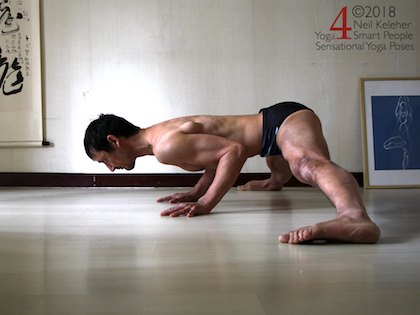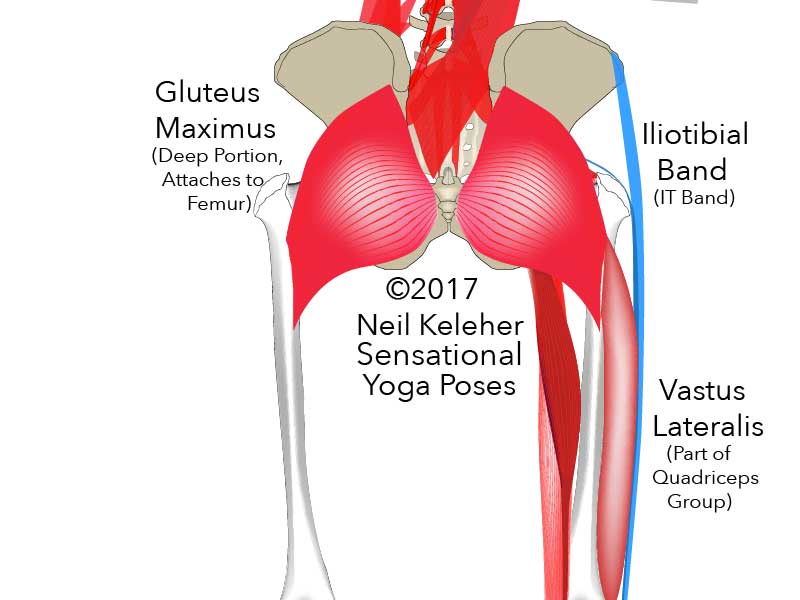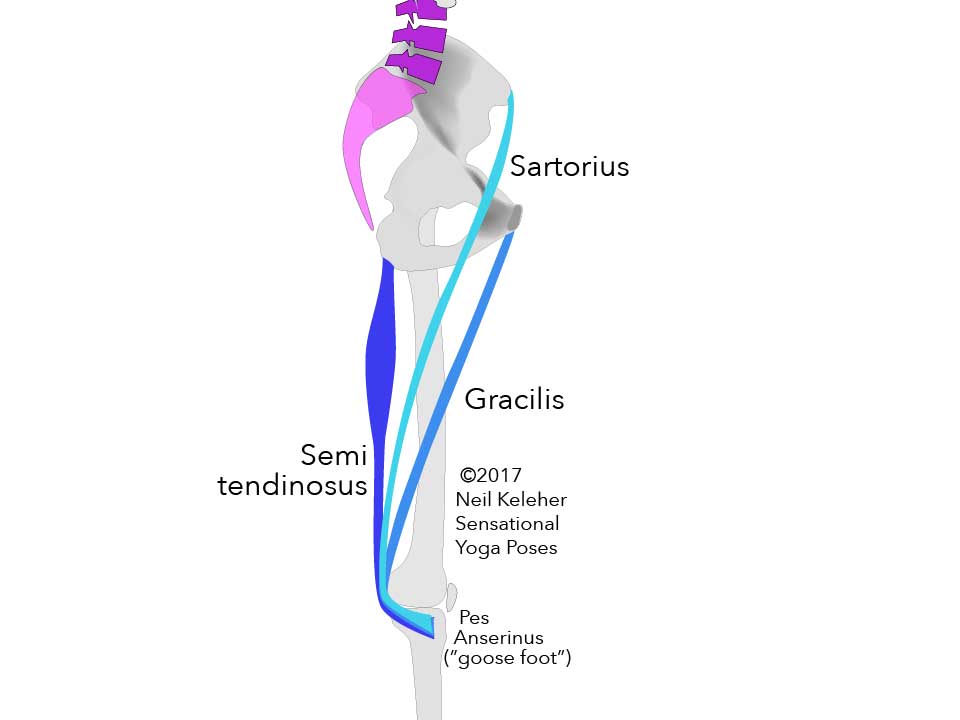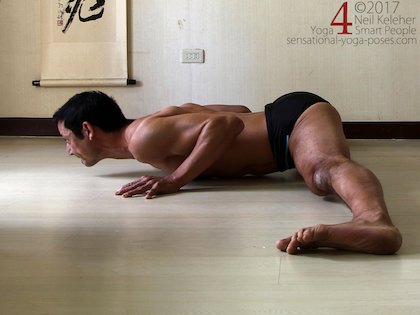The Gastrocnemius Can Help Stabilize the Knee Joint
Most discussions about the muscles of the knee focus on the quadriceps and hamstrings. The gastrocnemius muscle (the calf) is also an important muscle with respects to stabilizing the knee joint. And this is one muscle that you can practice activating while working on the middle splits. You can also practice activating it for the front leg in the front-to-back splits. I talk a little bit about the front-to-back splits in the article called Self Mastery.
So that you activate the gastrocnemius in a way that it affects the knee, I'd suggest focus on feeling the two sets of tendons at the back of the knee joint.
Once you've learned to activate the calfs (and possibly the hamstrings also) you can notice if one of these sets of tendons isn't active, particularly if this only occurs in one leg.
For a while I was solely focused on activating the calfs (and feeling them activate) and it wasn't without its benefits. My knees did feel more stable with the calfs activated.
Activating the calfs was the primary method of knee stabilization in an exercise I call the seated get up. .
However one shortcoming of this focus was that my calfs did begin to tighten up. So I'd suggest practicing calf activation as a method of knee stabilization only for a short while (say a month more or less.) And do supplement it with Calf Stretching.
Muscles that Work on the Sides of the Knee Joint
Other muscles that act on the knee are the lateral and medial thigh and hip muscles.
The Outside of the Knee
Focusing on the lateral or outer thigh and hip, an important structure is the IT Band. It's not a muscle. But it is worked on by the Tensor Fascia Latae and the superficial fibers of the Gluteus Maximus muscle as well as the Vastus Lateralis, the outer head of the Quadriceps group.
You could view the IT Band as a vast shared tendon with the front portion tending to be affected more by the Tensor Fascia Latae while the posterior part of it tends to be affected more by the Gluteus Maximus.
This band has been found to contain a deep layer. Where the more superficial layers connect between the crest of the hip bone and the top of the tibia, the deeper portion (deeper meaning "closer to the bone") of this band connects to the hip bone just in front of the hip joint.
The IT Band and Vastus Lateralis
The IT band not only passed over the Vastus lateralis muscle (the outermost quadriceps), it also has direct attachments to it so that tension in this muscle can add tension to the IT by creating a pull on these attachment points and additionally by pushing out against the band when it is active, in a similiar way to pushing out on braces with both hands can help to pull your trousers higher. (If you attach your braces to your underpants, then you can pull your underpants higher and give yourself a wedgy).
The IT band has connections both above and below the knee joint and so tension added to it can help stabilize the knee joint against lateral bending as well as rotation. It does this by working against inner thigh muscles not only to resist adduction but also by helping to control (or stabilize) rotation of the shin relative to the thigh.
Opposing Tension in the IT Band
On the opposite or medial side of the knee (the inside) an important structure is the pes anserinum, or goose foot. This structure is formed by the tendons of three muscles, the sartorius, gracilis and semitendinosus, all of which attach at key points of the pelvis. (Recall that the tensor fascia latae and gluteus maximus also attach to key points of the pelvis)
Together with the tension in the IT band, these muscles can also be used to help control or stabilize rotation of the shin relative to the thigh. They also can help drive adduction or help create stability by resisting abduction.
Controlling Adduction Below the Knee Joint
More important with respect to the middle splits is that these muscles resist adduction below the knee joint as opposed to above it (which is what the thigh adductors do). So learning to control these muscles these "knee" muscles may be key in arriving at or at least working towards side splits.
Gracilis and the Middle Splits
Of these "inner shin" muscles, the most important for me has been the gracilis, but that's just my own personal experience possible due to my own misadventures with my knees. If any of these muscles are not functioning correctly (or better put, the brain isn't turning them on as required) your splits may be inhibited. I've noticed that with better gracilis control I've been able to get closer to the splits, particular on my right side which has been my limiting side.
Note that because all of these muscles have an attachment to the pelvis, the position or alignment of your pelvis relative to each thigh can affect the tension and controllability of these muscles.
As you work deeper in the middle splits it may pay dividends to play with the front to back tilt and left to right turn and tilt of your pelvis. One side of your pelvis may be higher or further back or forwards than the other side. By moving slightly in any of the three main directions while paying attention to the feeling in your hip and knee, you can notice for yourself it you habitually tend towards an imbalanced position.
If you have a problem with a knee or hip, playing with pelvic alignment may help to deal with the problem.
Active Lengthening (Resisting the Stretch)
When working towards the middle splits it can be easy to believe that all you have to do is relax the muscles along the inside of the leg. And once you get the middle splits, this should be an option. However, working towards the splits, you may feel it more helpful to activate the gracilis and the other inner shin muscles..
The idea here is to control the gracilis (and sartorius and semitendinosus) so that they actively lengthen.
If these muscles stay active (while lengthening) , they can help maintain the integrity of the knee joint as you work towards the middle splits.
How to Move a Piano
This is akin to moving a piano from the tenth floor with a crane. You don't want to drop the piano by suddenly relaxing the cable while the piano is still suspended in mid-air. Instead you lower it with control. And that's how the gracilis (and its partners) can work when doing the splits. By keeping it active but lengthening as you lower deeper into the pose, it helps to keep the knee joint safe.
Creating A Stable Base for Sartorius and Gracilis
Because these muscles all attach to the pelvis, you may find it helpful to draw your ribcage away from your pelvis so that at the very least you create a pull on your ASICs. In this regard you may find it even more helpful to lift your bottom most pairs of ribs (11th and 12th and maybe even the 10th pair or ribs). The idea is to lengthen the obliques that attach there so that they pull upwards on the ASICs which then provides resistance to the Sartorius which also attaches there.
You could also experiment with pulling upwards on inwards (or both) on the inguinal ligament. I've seen no mention of an attachment between the inguinal ligament and the gracilis but I've found that it seems to help with Gracilis control. Note that pulling inwards on the inguinal ligament is more likely to activate the lower fibers of the Transverse Abdominis while pulling upwards is more likely to activate the elements of the external obliques that attach there.
How to Activate the Vastus Medialis Obliqus
Now a lot of talk has gone on about the vastus medialis obliqus. This is by some regarded as a separate muscle from the part of the vastus medialis that isn't oblique.
Now if this muscle isn't functioning properly that too may be reason enough for your brain to curtail your efforts at getting to the middle splits.
To activate any muscle easily it helps to make one end point of the muscle stable. You could think of this as anchoring the muscle.
Since the Vastus Medialis Obliqus attaches at the upper end to the adductor magnus muscle and at the lower end to the knee cap, one way to anchor this muscle is to first activate the long head of the Adductor Magnus. If this muscle is engaged, then the vastus medialis obliqus has a stable foundation from which to act on the knee joint.
Making Muscles Awailable
Note in the picture below my VMO isn't active. But on the way to getting that low it helped when I activated this muscle.
And that may be part of the way the brain is programmed to operate the body. If it thinks that a muscle (such as the vastus medialus obliqus) isn't available, then it shuts down your splits before you reach a point where that muscle would actually be needed to maintain knee joint integrity. It may be enough just for the brain to know that this muscle can activate so that it can then activate it at will.
Guidelines for Using Muscle Control To Work Towards Middle Splits
One challenge with teaching something like the middle splits is that every body is different. For me the the gracilis (and the vastus medialis obliqus) where just some of the elements holding me back. Depending on your own history, you may have to work with other problem muscles.
The muscles that work on your hips, knees and feet all work together to keep all of those joints safe as you lower down. With any failure in muscle control the brain may put on the brakes and prevent you from going deeper. So the better you are at controlling and feeling your muscles, the more likely you are to find what element of muscle control missing.
And that's why feeling is so important. As you get better at feeling your body while, say, doing the middle splits, you can notice areas of excessive tension or lack of tension which indicates a failure in muscle control somewhere. And this is where understanding that muscles help maintain joint integrity can be helpful. Excessive tension could indicate a muscle is substituting for another muscle to keep a joint safe. A lack of tension also means something isn't working that needs to be.
And that's one of the nice things about the middlesplits. It's a symmetrical position and that means you can feel one leg (foot, hip and knee and the muscles that work on them) and use it as a reference for the other leg.
Published: 2018 02 05






